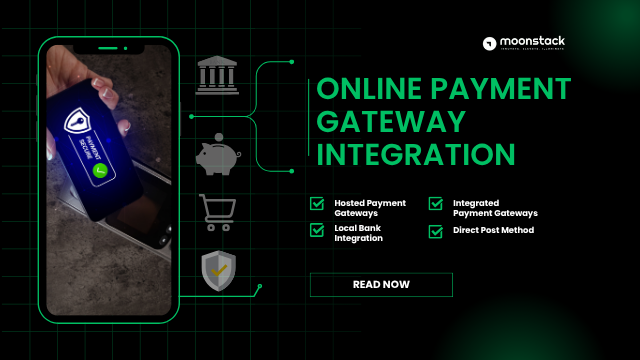How AI and Machine Learning Are Transforming Mobile App Development in 2025


Making the right payment gateway choice is essential to improving the shopping experience for customers. For e-commerce businesses to succeed, a variety of payment methods must be easily accepted. However, there are complex steps involved in integrating payment gateways.
With more than 10 years of experience developing custom software, Moonstack is well-versed in the technical requirements for incorporating payment gateways into e-commerce platforms. Our expertise enables us to provide businesses with thorough information about permitting their clients’ preferred payment methods. This article explores the various kinds and characteristics of gateway systems and looks at the related integration expenses.
Types of Payment Gateways
Payment gateways serve as electronic guardians for monetary exchanges. During online transactions, they protect the money transfer from the buyer’s bank to the seller’s. The needs of your business, your technological expertise, and the kind of client experience you want to provide will all play a role in the payment gateway you choose.
Hosted Payment Gateways
Following a transaction, these gateways return users to the original website by redirecting them to the gateway’s platform.
Since the processor handles security and PCI compliance, they are simple to build and monitor. However, the user experience may be disrupted by this redirection, which could result in cart abandonment.
Integrated Payment Gateways
Through the use of APIs, these gateways integrate smoothly with e-commerce websites, enabling in-site transaction processing.
Although they require technical expertise for setup and upkeep, integrated gateways improve user experience and brand consistency. The company is also responsible for certain security and PCI compliance duties.
Self-hosted Payment Gateways
Under this paradigm, businesses gather payment details and send them to the gateway’s URL.
Self-hosted gateways provide you complete control over how users interact with you. However, there are more security and regulatory requirements when managing client data directly.
Local Bank Integration
After making a payment on their bank’s website, customers are taken back to the original website.
Because bank interfaces are familiar, this approach is frequently seen as more reliable. However, redirecting may turn off some clients, just like hosted gateways do.
Direct Post Method
While the gateway’s servers carry out the transaction, payment processing takes place on the company’s website. The user usually doesn’t notice this change.
This kind divides security duties between the payment processor and the company’s website. However, the company still has some security responsibilities.
Mobile Payment Gateways
These are made especially for mobile apps that are tailored for seamless transactions.
This strategy takes advantage of the growing mobile commerce market and speeds up mobile checkouts. On the other hand, some gateways may require extra mobile platform setups or integration.
Important Elements of Payment Gateways
A good payment gateway does more than just make transactions easier. It should be dependable, flexible, safe, and easy to use. Businesses should take into account the following characteristics while looking for the best gateway:
Strong Security and Preventing Fraud
In addition to offering fraud prevention tools like address verification systems (AVS) and card verification value (CVV) checks, payment gateways should use SSL encryption and tokenization.
Effortless Integration
Easy Integration Gateway APIs should offer SDKs for developers to utilize, be interoperable with major shopping carts and e-commerce systems, and connect seamlessly with a variety of platforms.
User-Oriented Design
Mobile optimization is becoming more and more beneficial, and gateways need to be intuitively designed with quick checkout alternatives.
Reliable Customer Service
Help should be available by phone, chat, and email at all times.
Adaptable Reporting Features
Sales and performance insights are obtained through customized reporting options and real-time analytics.
The feature of recurring billing
For companies using subscription models, gateways should provide flexible billing schedules and facilitate automated recurring payments.
Various Payment Options
Major credit and debit cards, well-known digital wallets, bank transfers, and cryptocurrency integration should all be supported by gateways.
Maximum Reliability and Uptime
Systems should always be up and running, reducing downtime and completing transactions quickly.
Selecting the Correct Payment Gateway
When selecting a gateway, take into account variables that affect sales, trust, and client abandonment. Here are some things to think about:
Security Standards
Check the gateway’s ability to prevent fraud and compliance with PCI DSS regulations.
Cost Analysis
Look over the gateway’s pricing schedule, taking note of setup fees, monthly fees, transaction fees, and any other hidden costs.
Support for Payment Methods
Select a gateway that accepts a range of payment options, including e-wallets and credit/debit cards.
International and Multi-Currency Assistance
For global reach, make sure the gateway offers localized payment methods and currency conversion for various nations or regions.
Feedback and Reputation
Get information about other companies’ experiences with possible gateways.
How Do Gateways for Payments Operate?
Even with a large volume of transactions, payment gateways only take a few seconds to finish the online transaction procedure.
- Consumers check out and pay online by entering their payment details. Customers’ information is encrypted before being sent to the payment processor by the payment gateways. For authentication, it sends the data to the relevant bank.
- The information is verified by the relevant bank. The outcome is then sent to the payment processor for additional handling.
- The results are then sent to the payment gateways by the payment processor. The final transaction status is finally sent to the merchant’s website before items are shipped.
How Payment Gateway Integration is Beneficial for Your Business?
By including payment gateways in their fintech apps, businesses can take advantage of a number of advantages, including
- Third-party payment gateway integrations like PayPal and Stripe are supported by e-commerce platforms like Shopify and WooCommerce. Companies manage a large volume of transactions on their website and pay a charge.
- Payment gateway integration costs, including development and maintenance costs, can be significantly reduced by using third-party solutions.
- Payment gateways make it simple to track payments, manage refunds, and settle claims.
- You may entice other businesses to join your platform and create passive income by integrating your bespoke payment gateway.
Keep in mind that despite all of the advantages, the payment gateway sector nonetheless faces numerous difficulties. These obstacles must be solved in order to select and develop a worthwhile payment gateway system.
Connect with Moonstack
Ready to take the first step towards unlocking opportunities, realizing goals, and embracing innovation? We're here and eager to connect.


